Corporate Finance (BUSS 5233) Assignment - Study Period 2, 2019
VerifiedAdded on 2023/01/18
|7
|1189
|35
Homework Assignment
AI Summary
This assignment analyzes the impact of the global financial crisis and the Reserve Bank of Australia's (RBA) monetary policy on the Australian cash rate. The solution examines the effects of the crisis on the financial market, including increased spreads in the short-term money market and the RBA's response by adjusting the cash supply. It discusses the fluctuations in the cash rate, the RBA's decisions to maintain low rates, and the economic factors influencing these decisions, such as domestic uncertainty, falling house prices, household spending, and economic forecasts. The assignment also explores the RBA's projections for inflation, wage growth, and GDP growth, and how these factors influence the monetary policy stance, concluding that the RBA would likely loosen its monetary policy to meet the economic challenges.
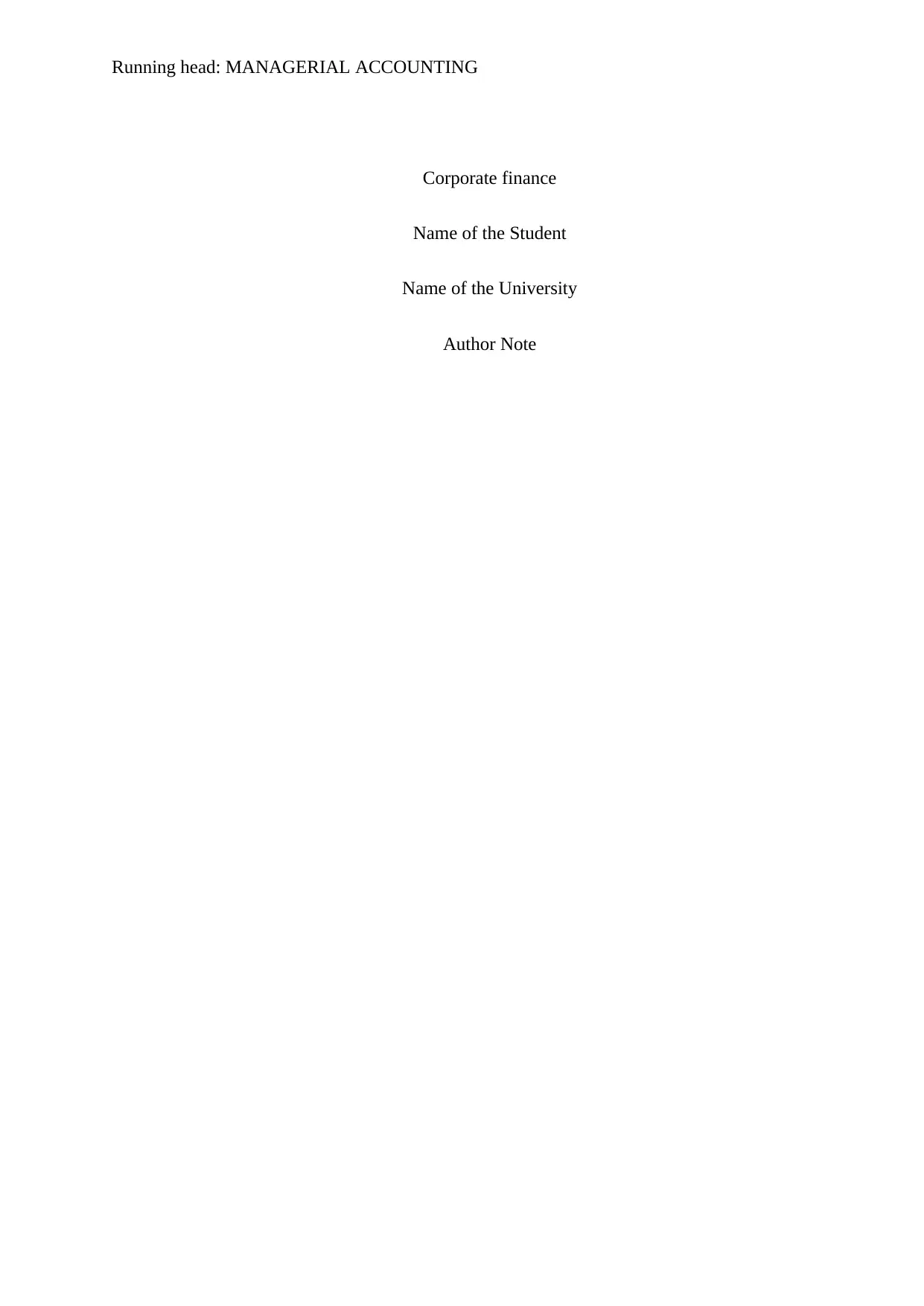
Running head: MANAGERIAL ACCOUNTING
Corporate finance
Name of the Student
Name of the University
Author Note
Corporate finance
Name of the Student
Name of the University
Author Note
Paraphrase This Document
Need a fresh take? Get an instant paraphrase of this document with our AI Paraphraser
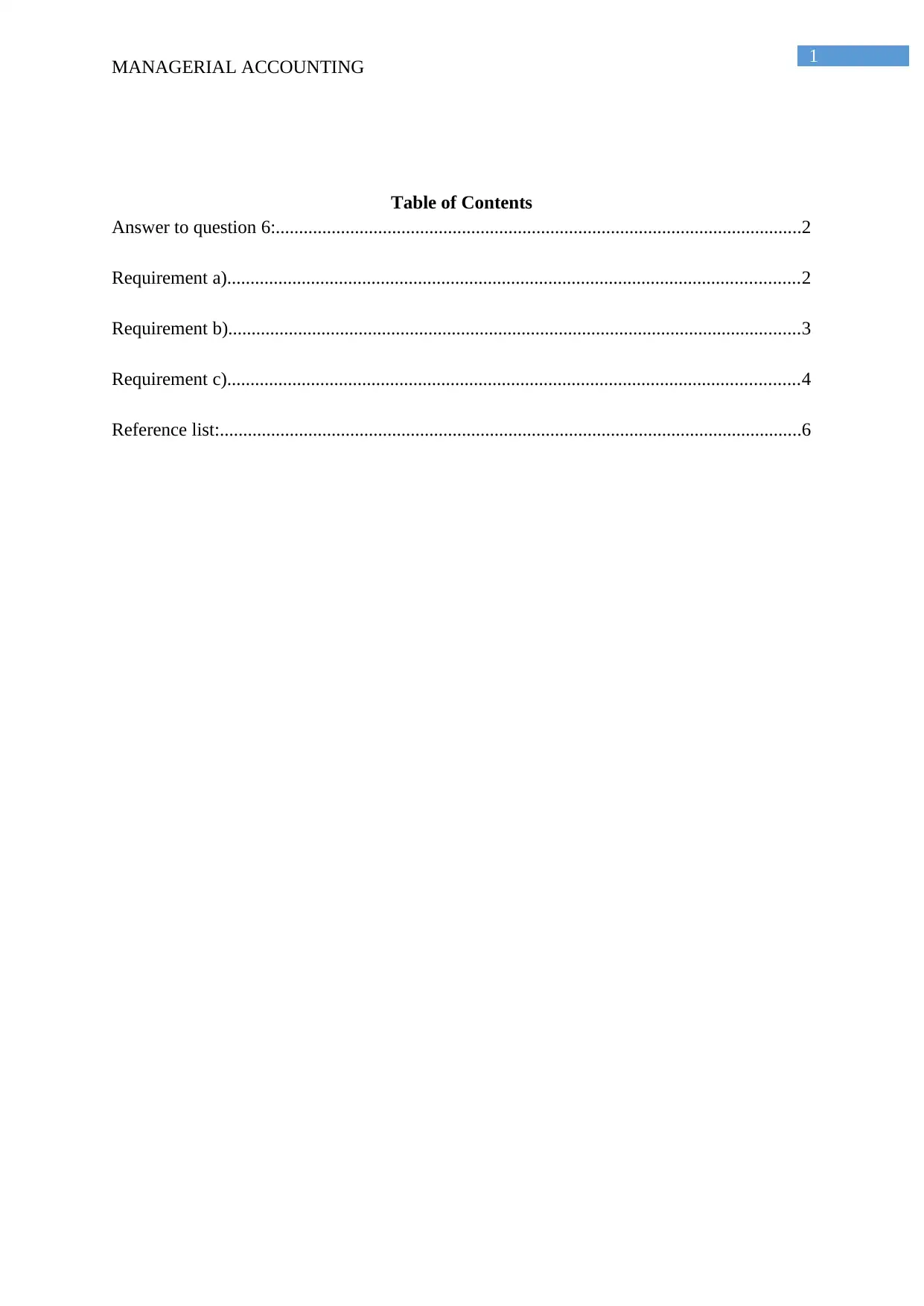
1
MANAGERIAL ACCOUNTING
Table of Contents
Answer to question 6:.................................................................................................................2
Requirement a)...........................................................................................................................2
Requirement b)...........................................................................................................................3
Requirement c)...........................................................................................................................4
Reference list:.............................................................................................................................6
MANAGERIAL ACCOUNTING
Table of Contents
Answer to question 6:.................................................................................................................2
Requirement a)...........................................................................................................................2
Requirement b)...........................................................................................................................3
Requirement c)...........................................................................................................................4
Reference list:.............................................................................................................................6
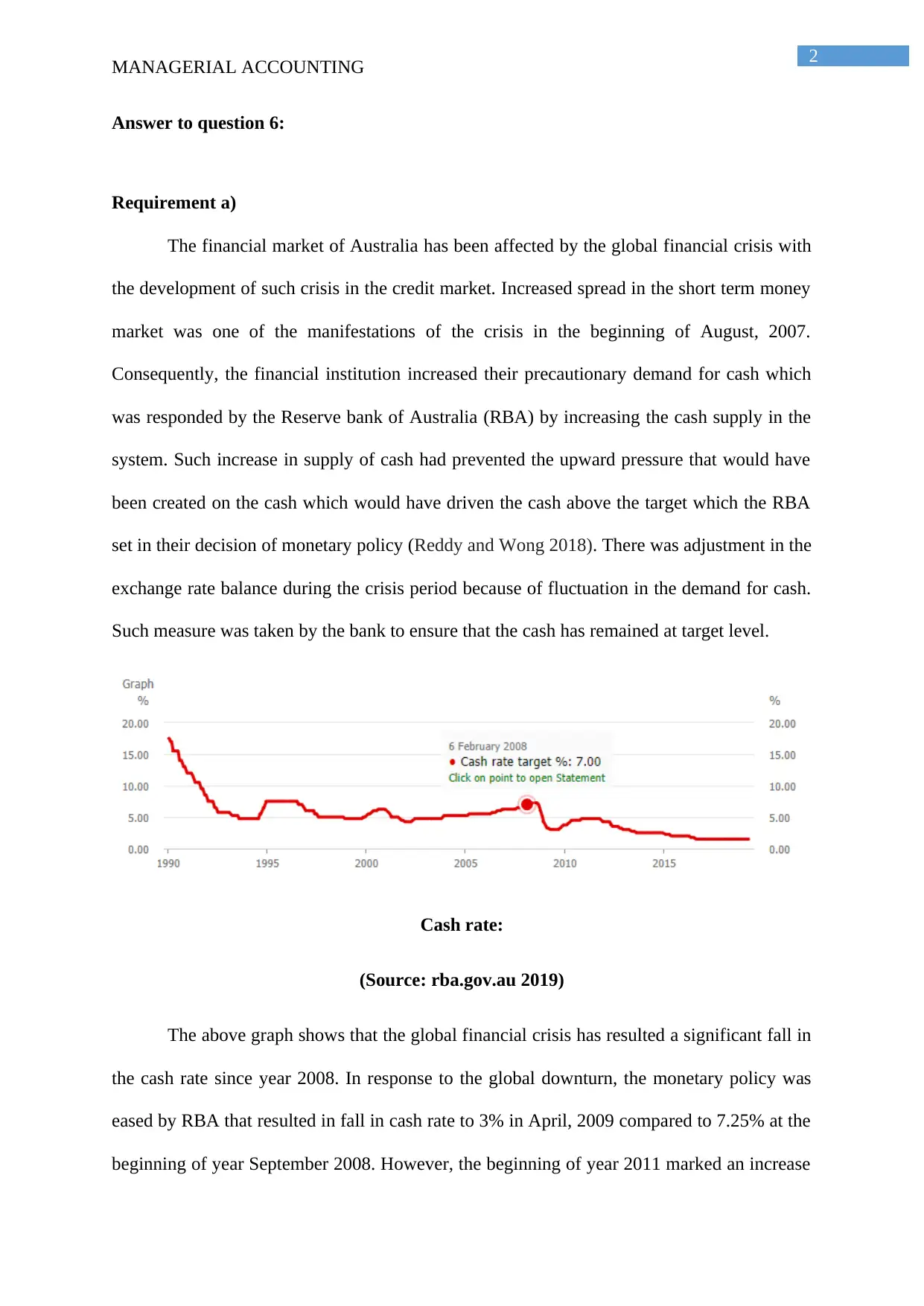
2
MANAGERIAL ACCOUNTING
Answer to question 6:
Requirement a)
The financial market of Australia has been affected by the global financial crisis with
the development of such crisis in the credit market. Increased spread in the short term money
market was one of the manifestations of the crisis in the beginning of August, 2007.
Consequently, the financial institution increased their precautionary demand for cash which
was responded by the Reserve bank of Australia (RBA) by increasing the cash supply in the
system. Such increase in supply of cash had prevented the upward pressure that would have
been created on the cash which would have driven the cash above the target which the RBA
set in their decision of monetary policy (Reddy and Wong 2018). There was adjustment in the
exchange rate balance during the crisis period because of fluctuation in the demand for cash.
Such measure was taken by the bank to ensure that the cash has remained at target level.
Cash rate:
(Source: rba.gov.au 2019)
The above graph shows that the global financial crisis has resulted a significant fall in
the cash rate since year 2008. In response to the global downturn, the monetary policy was
eased by RBA that resulted in fall in cash rate to 3% in April, 2009 compared to 7.25% at the
beginning of year September 2008. However, the beginning of year 2011 marked an increase
MANAGERIAL ACCOUNTING
Answer to question 6:
Requirement a)
The financial market of Australia has been affected by the global financial crisis with
the development of such crisis in the credit market. Increased spread in the short term money
market was one of the manifestations of the crisis in the beginning of August, 2007.
Consequently, the financial institution increased their precautionary demand for cash which
was responded by the Reserve bank of Australia (RBA) by increasing the cash supply in the
system. Such increase in supply of cash had prevented the upward pressure that would have
been created on the cash which would have driven the cash above the target which the RBA
set in their decision of monetary policy (Reddy and Wong 2018). There was adjustment in the
exchange rate balance during the crisis period because of fluctuation in the demand for cash.
Such measure was taken by the bank to ensure that the cash has remained at target level.
Cash rate:
(Source: rba.gov.au 2019)
The above graph shows that the global financial crisis has resulted a significant fall in
the cash rate since year 2008. In response to the global downturn, the monetary policy was
eased by RBA that resulted in fall in cash rate to 3% in April, 2009 compared to 7.25% at the
beginning of year September 2008. However, the beginning of year 2011 marked an increase
⊘ This is a preview!⊘
Do you want full access?
Subscribe today to unlock all pages.

Trusted by 1+ million students worldwide
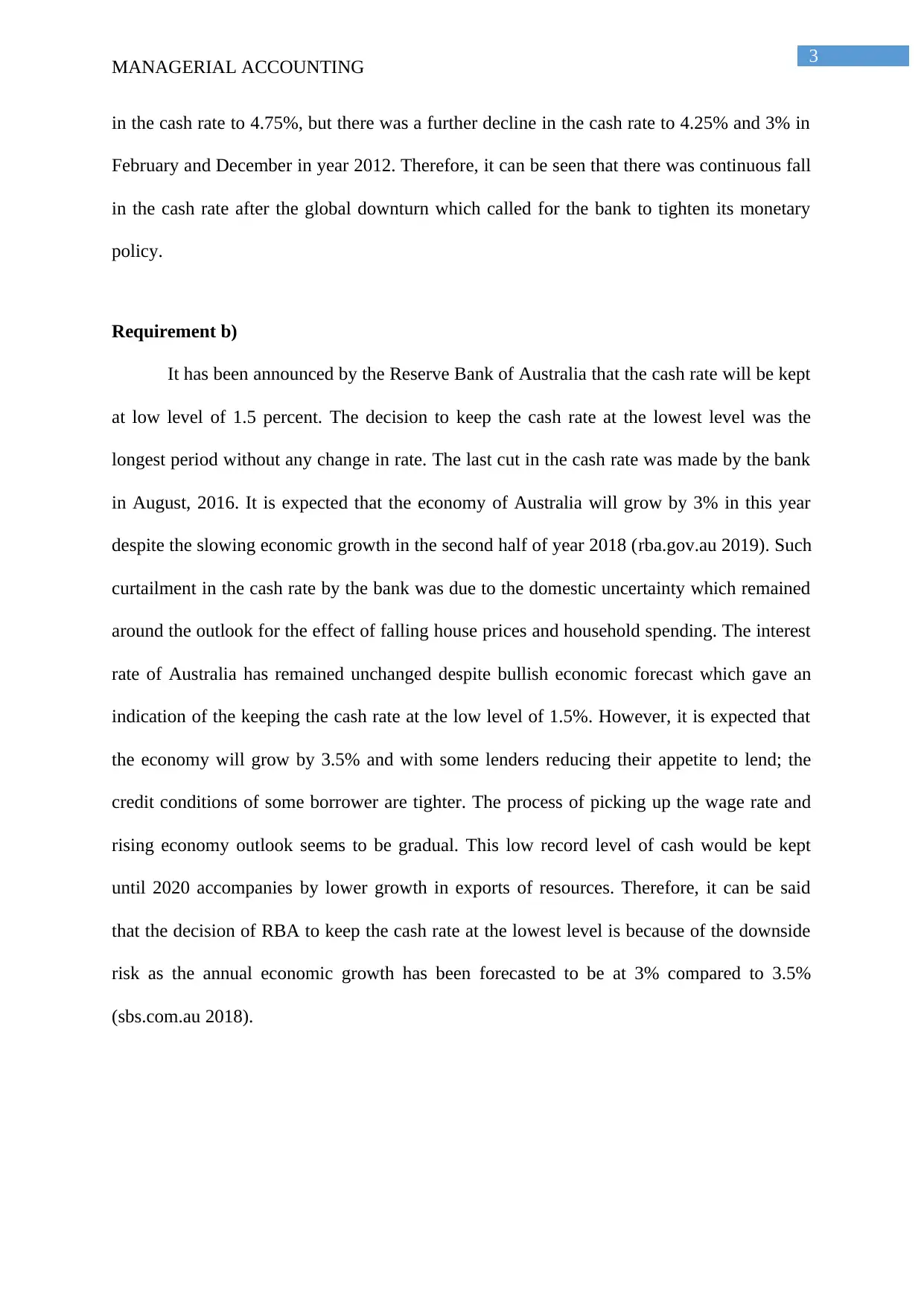
3
MANAGERIAL ACCOUNTING
in the cash rate to 4.75%, but there was a further decline in the cash rate to 4.25% and 3% in
February and December in year 2012. Therefore, it can be seen that there was continuous fall
in the cash rate after the global downturn which called for the bank to tighten its monetary
policy.
Requirement b)
It has been announced by the Reserve Bank of Australia that the cash rate will be kept
at low level of 1.5 percent. The decision to keep the cash rate at the lowest level was the
longest period without any change in rate. The last cut in the cash rate was made by the bank
in August, 2016. It is expected that the economy of Australia will grow by 3% in this year
despite the slowing economic growth in the second half of year 2018 (rba.gov.au 2019). Such
curtailment in the cash rate by the bank was due to the domestic uncertainty which remained
around the outlook for the effect of falling house prices and household spending. The interest
rate of Australia has remained unchanged despite bullish economic forecast which gave an
indication of the keeping the cash rate at the low level of 1.5%. However, it is expected that
the economy will grow by 3.5% and with some lenders reducing their appetite to lend; the
credit conditions of some borrower are tighter. The process of picking up the wage rate and
rising economy outlook seems to be gradual. This low record level of cash would be kept
until 2020 accompanies by lower growth in exports of resources. Therefore, it can be said
that the decision of RBA to keep the cash rate at the lowest level is because of the downside
risk as the annual economic growth has been forecasted to be at 3% compared to 3.5%
(sbs.com.au 2018).
MANAGERIAL ACCOUNTING
in the cash rate to 4.75%, but there was a further decline in the cash rate to 4.25% and 3% in
February and December in year 2012. Therefore, it can be seen that there was continuous fall
in the cash rate after the global downturn which called for the bank to tighten its monetary
policy.
Requirement b)
It has been announced by the Reserve Bank of Australia that the cash rate will be kept
at low level of 1.5 percent. The decision to keep the cash rate at the lowest level was the
longest period without any change in rate. The last cut in the cash rate was made by the bank
in August, 2016. It is expected that the economy of Australia will grow by 3% in this year
despite the slowing economic growth in the second half of year 2018 (rba.gov.au 2019). Such
curtailment in the cash rate by the bank was due to the domestic uncertainty which remained
around the outlook for the effect of falling house prices and household spending. The interest
rate of Australia has remained unchanged despite bullish economic forecast which gave an
indication of the keeping the cash rate at the low level of 1.5%. However, it is expected that
the economy will grow by 3.5% and with some lenders reducing their appetite to lend; the
credit conditions of some borrower are tighter. The process of picking up the wage rate and
rising economy outlook seems to be gradual. This low record level of cash would be kept
until 2020 accompanies by lower growth in exports of resources. Therefore, it can be said
that the decision of RBA to keep the cash rate at the lowest level is because of the downside
risk as the annual economic growth has been forecasted to be at 3% compared to 3.5%
(sbs.com.au 2018).
Paraphrase This Document
Need a fresh take? Get an instant paraphrase of this document with our AI Paraphraser
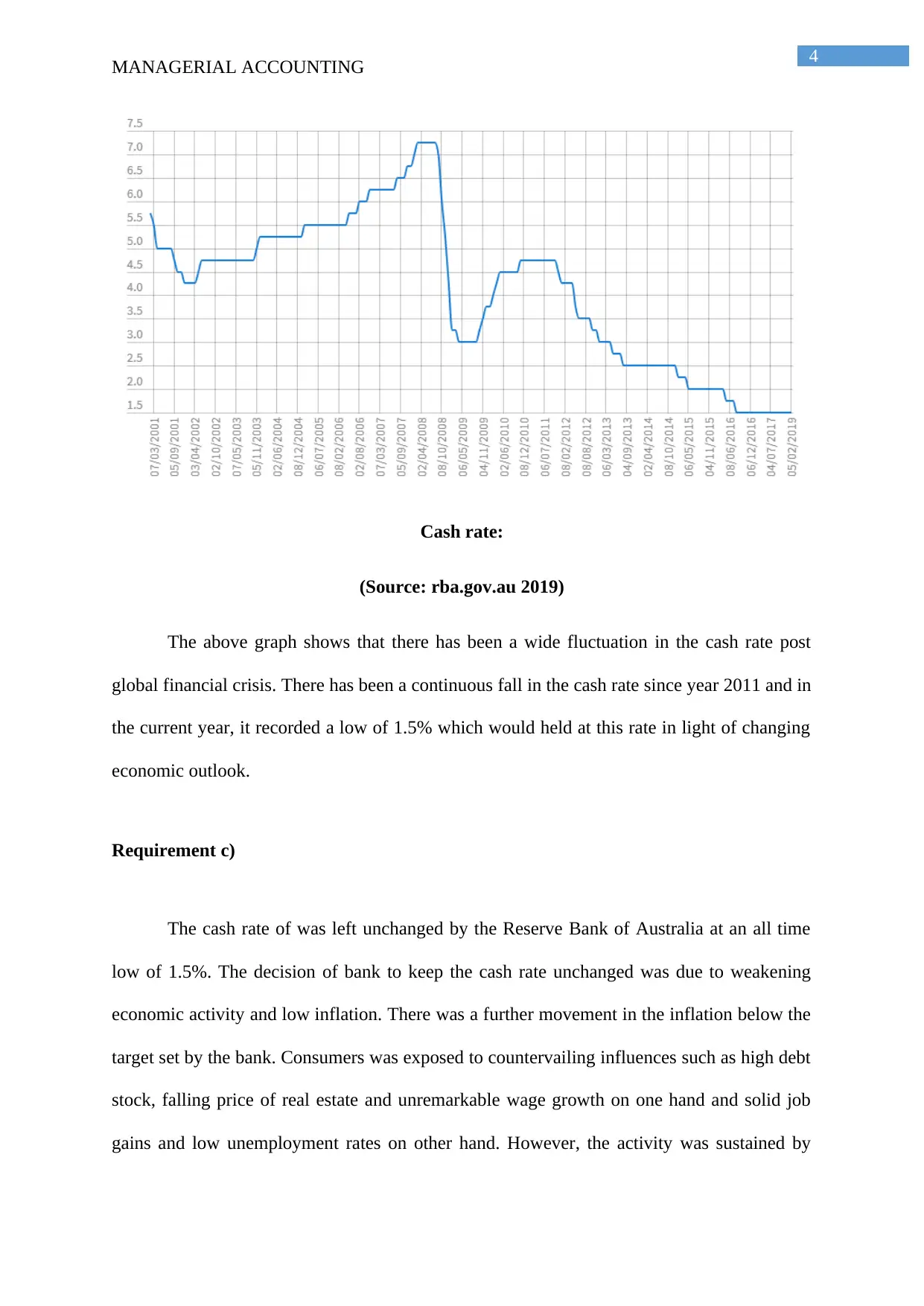
4
MANAGERIAL ACCOUNTING
Cash rate:
(Source: rba.gov.au 2019)
The above graph shows that there has been a wide fluctuation in the cash rate post
global financial crisis. There has been a continuous fall in the cash rate since year 2011 and in
the current year, it recorded a low of 1.5% which would held at this rate in light of changing
economic outlook.
Requirement c)
The cash rate of was left unchanged by the Reserve Bank of Australia at an all time
low of 1.5%. The decision of bank to keep the cash rate unchanged was due to weakening
economic activity and low inflation. There was a further movement in the inflation below the
target set by the bank. Consumers was exposed to countervailing influences such as high debt
stock, falling price of real estate and unremarkable wage growth on one hand and solid job
gains and low unemployment rates on other hand. However, the activity was sustained by
MANAGERIAL ACCOUNTING
Cash rate:
(Source: rba.gov.au 2019)
The above graph shows that there has been a wide fluctuation in the cash rate post
global financial crisis. There has been a continuous fall in the cash rate since year 2011 and in
the current year, it recorded a low of 1.5% which would held at this rate in light of changing
economic outlook.
Requirement c)
The cash rate of was left unchanged by the Reserve Bank of Australia at an all time
low of 1.5%. The decision of bank to keep the cash rate unchanged was due to weakening
economic activity and low inflation. There was a further movement in the inflation below the
target set by the bank. Consumers was exposed to countervailing influences such as high debt
stock, falling price of real estate and unremarkable wage growth on one hand and solid job
gains and low unemployment rates on other hand. However, the activity was sustained by
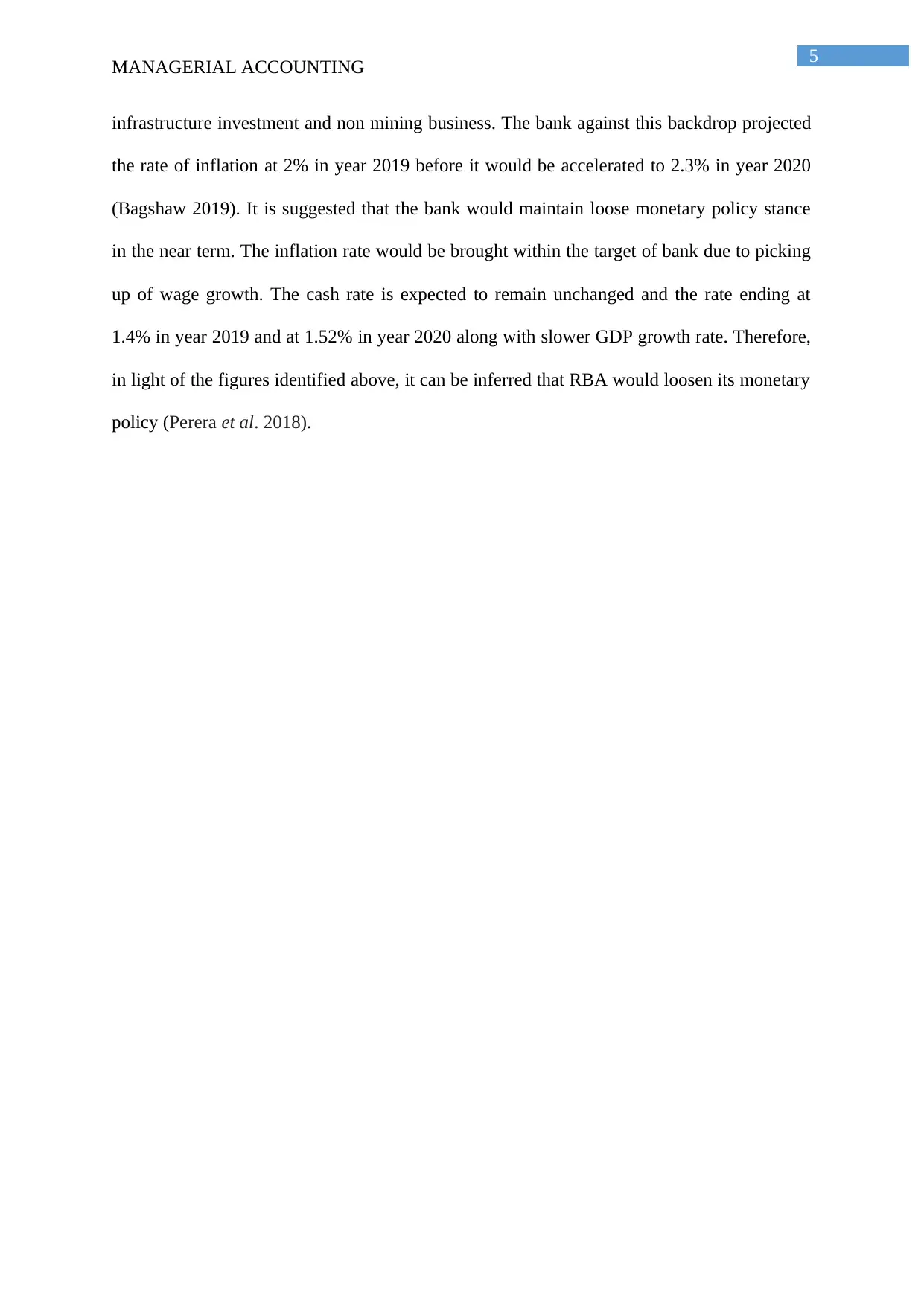
5
MANAGERIAL ACCOUNTING
infrastructure investment and non mining business. The bank against this backdrop projected
the rate of inflation at 2% in year 2019 before it would be accelerated to 2.3% in year 2020
(Bagshaw 2019). It is suggested that the bank would maintain loose monetary policy stance
in the near term. The inflation rate would be brought within the target of bank due to picking
up of wage growth. The cash rate is expected to remain unchanged and the rate ending at
1.4% in year 2019 and at 1.52% in year 2020 along with slower GDP growth rate. Therefore,
in light of the figures identified above, it can be inferred that RBA would loosen its monetary
policy (Perera et al. 2018).
MANAGERIAL ACCOUNTING
infrastructure investment and non mining business. The bank against this backdrop projected
the rate of inflation at 2% in year 2019 before it would be accelerated to 2.3% in year 2020
(Bagshaw 2019). It is suggested that the bank would maintain loose monetary policy stance
in the near term. The inflation rate would be brought within the target of bank due to picking
up of wage growth. The cash rate is expected to remain unchanged and the rate ending at
1.4% in year 2019 and at 1.52% in year 2020 along with slower GDP growth rate. Therefore,
in light of the figures identified above, it can be inferred that RBA would loosen its monetary
policy (Perera et al. 2018).
⊘ This is a preview!⊘
Do you want full access?
Subscribe today to unlock all pages.

Trusted by 1+ million students worldwide
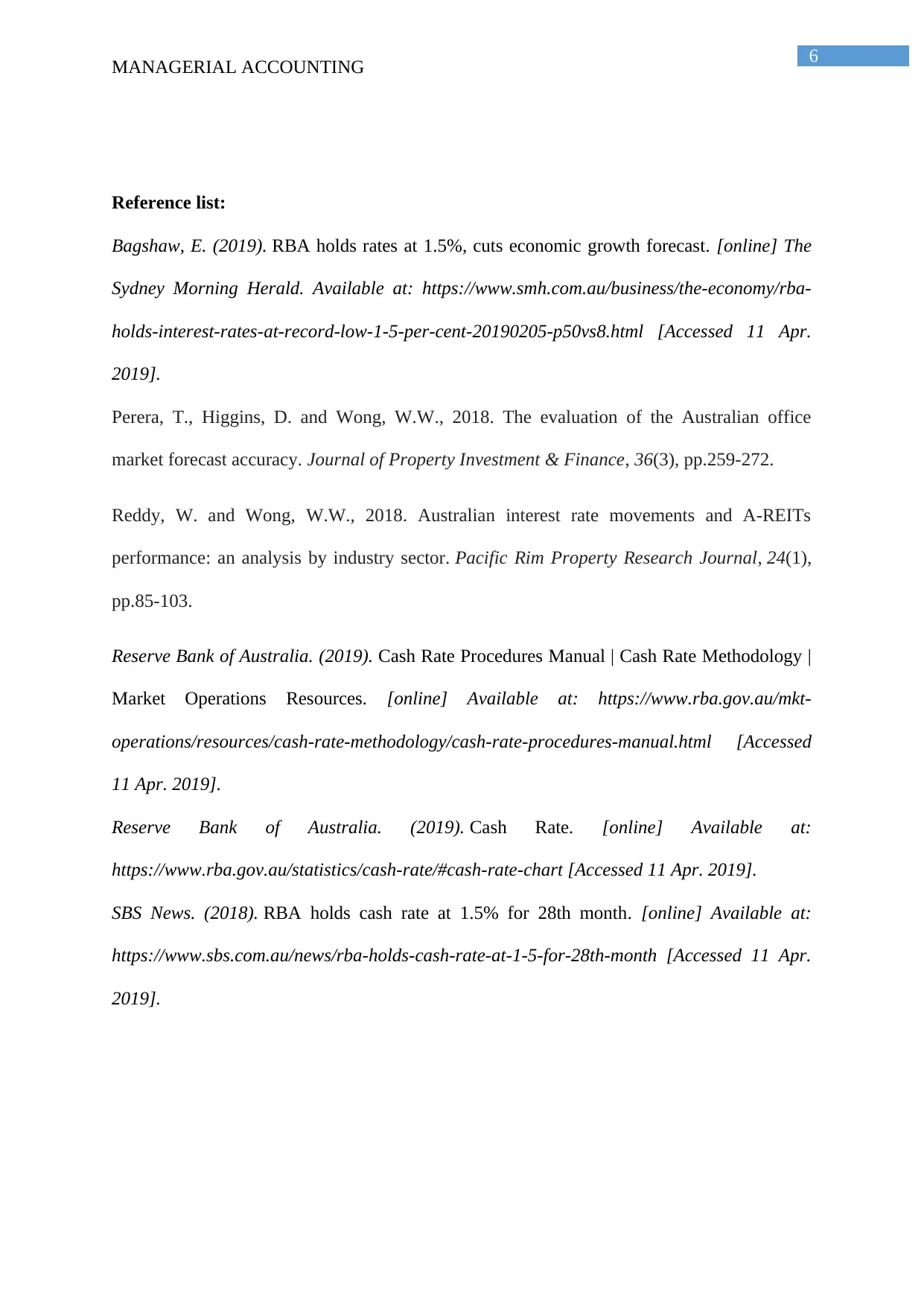
6
MANAGERIAL ACCOUNTING
Reference list:
Bagshaw, E. (2019). RBA holds rates at 1.5%, cuts economic growth forecast. [online] The
Sydney Morning Herald. Available at: https://www.smh.com.au/business/the-economy/rba-
holds-interest-rates-at-record-low-1-5-per-cent-20190205-p50vs8.html [Accessed 11 Apr.
2019].
Perera, T., Higgins, D. and Wong, W.W., 2018. The evaluation of the Australian office
market forecast accuracy. Journal of Property Investment & Finance, 36(3), pp.259-272.
Reddy, W. and Wong, W.W., 2018. Australian interest rate movements and A-REITs
performance: an analysis by industry sector. Pacific Rim Property Research Journal, 24(1),
pp.85-103.
Reserve Bank of Australia. (2019). Cash Rate Procedures Manual | Cash Rate Methodology |
Market Operations Resources. [online] Available at: https://www.rba.gov.au/mkt-
operations/resources/cash-rate-methodology/cash-rate-procedures-manual.html [Accessed
11 Apr. 2019].
Reserve Bank of Australia. (2019). Cash Rate. [online] Available at:
https://www.rba.gov.au/statistics/cash-rate/#cash-rate-chart [Accessed 11 Apr. 2019].
SBS News. (2018). RBA holds cash rate at 1.5% for 28th month. [online] Available at:
https://www.sbs.com.au/news/rba-holds-cash-rate-at-1-5-for-28th-month [Accessed 11 Apr.
2019].
MANAGERIAL ACCOUNTING
Reference list:
Bagshaw, E. (2019). RBA holds rates at 1.5%, cuts economic growth forecast. [online] The
Sydney Morning Herald. Available at: https://www.smh.com.au/business/the-economy/rba-
holds-interest-rates-at-record-low-1-5-per-cent-20190205-p50vs8.html [Accessed 11 Apr.
2019].
Perera, T., Higgins, D. and Wong, W.W., 2018. The evaluation of the Australian office
market forecast accuracy. Journal of Property Investment & Finance, 36(3), pp.259-272.
Reddy, W. and Wong, W.W., 2018. Australian interest rate movements and A-REITs
performance: an analysis by industry sector. Pacific Rim Property Research Journal, 24(1),
pp.85-103.
Reserve Bank of Australia. (2019). Cash Rate Procedures Manual | Cash Rate Methodology |
Market Operations Resources. [online] Available at: https://www.rba.gov.au/mkt-
operations/resources/cash-rate-methodology/cash-rate-procedures-manual.html [Accessed
11 Apr. 2019].
Reserve Bank of Australia. (2019). Cash Rate. [online] Available at:
https://www.rba.gov.au/statistics/cash-rate/#cash-rate-chart [Accessed 11 Apr. 2019].
SBS News. (2018). RBA holds cash rate at 1.5% for 28th month. [online] Available at:
https://www.sbs.com.au/news/rba-holds-cash-rate-at-1-5-for-28th-month [Accessed 11 Apr.
2019].
1 out of 7
Related Documents
Your All-in-One AI-Powered Toolkit for Academic Success.
+13062052269
info@desklib.com
Available 24*7 on WhatsApp / Email
![[object Object]](/_next/static/media/star-bottom.7253800d.svg)
Unlock your academic potential
Copyright © 2020–2025 A2Z Services. All Rights Reserved. Developed and managed by ZUCOL.





